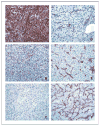Tumor cell and tumor vasculature expression of B7-H3 predict survival in clear cell renal cell carcinoma
- PMID: 18694993
- PMCID: PMC2789387
- DOI: 10.1158/1078-0432.CCR-08-0536
Tumor cell and tumor vasculature expression of B7-H3 predict survival in clear cell renal cell carcinoma
Abstract
Purpose: Although the prognostic value of B7-H1 and B7-H4 expression by tumor cells in clear cell renal cell carcinoma (ccRCC) has been established, the role of B7-H3 is unknown. As such, we evaluated the association of B7-H3 expression with clinicopathologic outcomes in patients treated for ccRCC.
Experimental design: Nephrectomy specimens from 743 consecutive patients treated for ccRCC at our institution from 1990 to 1999 were evaluated for B7-H3 expression by immunohistochemical staining. Associations of B7-H3 expression with clinical and pathologic features were evaluated using chi2 and Fisher's exact tests. Associations of B7-H3 expression with death from RCC were evaluated using Cox proportional hazards regression models.
Results: B7-H3 expression by tumor cells or tumor vasculature was noted in 17% and 95% of specimens, respectively. The presence of either tumor cell or diffuse tumor vasculature expression of B7-H3 was present in 46% of specimens and was associated with multiple adverse clinical and pathologic features. After multivariable adjustment, the presence of either tumor cell or diffuse tumor vasculature B7-H3 expression was significantly associated with an increased risk of death from RCC (risk ratio, 1.38; 95% confidence interval, 1.03-1.84; P = 0.029).
Conclusions: Both tumor cell and tumor vasculature B7-H3 expression convey important information to predict ccRCC outcomes. Collectively, our past and present studies pertaining to B7-H ligand expression indicate that ccRCC may use redundant mechanisms to compromise host antitumoral immunity. Future studies will focus on the effect of combined B7-H ligand expression in RCC.
Conflict of interest statement
Y. Sheinin,T.J. Roth, C.M. Lohse, and E.D. Kwon have filed a patent on B7-H3 prognostic marker.
Figures


References
-
- Eggener SE, Yossepowitch O, Pettus JA, Snyder ME, Motzer RJ, Russo P. Renal cell carcinoma recurrence after nephrectomy for localized disease: predicting survival from time of recurrence. J Clin Oncol. 2006;24:3101–6. - PubMed
-
- Motzer RJ, Mazumdar M, Bacik J, Berg W, Amsterdam A, Ferrara J. Survival and prognostic stratification of 670 patients with advanced renal cell carcinoma. J Clin Oncol. 1999;17:2530–40. - PubMed
-
- Fyfe G, Fisher RI, Rosenberg SA, Sznol M, Parkinson DR, Louie AC. Results of treatment of 255 patients with metastatic renal cell carcinoma who received high-dose recombinant interleukin-2 therapy. J Clin Oncol. 1995;13:688–96. - PubMed
-
- Fisher RI, Rosenberg SA, Fyfe G. Long-term survival update for high-dose recombinant interleukin-2 in patients with renal cell carcinoma. Cancer J Sci Am. 2000;6 1:S55–7. - PubMed
-
- Hudes G, Carducci M, Tomcz P, et al. Temsirolimus, interferon α, or both for advanced renal-cell carcinoma. N Engl J Med. 2007;356:2271–81. - PubMed
Publication types
MeSH terms
Substances
Grants and funding
LinkOut - more resources
Full Text Sources
Other Literature Sources
Medical
Research Materials
Miscellaneous

